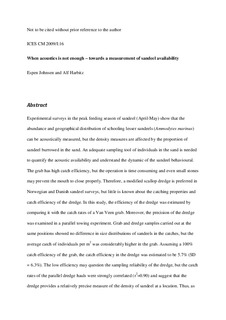| dc.description.abstract | Experimental surveys in the peak feeding season of sandeel (April-May) show that the abundance and geographical distribution of schooling lesser sandeels (Ammodytes marinus) can be acoustically measured, but the density measures are affected by the proportion of sandeel burrowed in the sand. An adequate sampling tool of individuals in the sand is needed to quantify the acoustic availability and understand the dynamic of the sandeel behavioural. The grab has high catch efficiency, but the operation is time consuming and even small stones may prevent the mouth to close properly. Therefore, a modified scallop dredge is preferred in Norwegian and Danish sandeel surveys, but little is known about the catching properties and catch efficiency of the dredge. In this study, the efficiency of the dredge was estimated by comparing it with the catch rates of a Van Veen grab. Moreover, the precision of the dredge was examined in a parallel towing experiment. Grab and dredge samples carried out at the same positions showed no difference in size distributions of sandeels in the catches, but the average catch of individuals per m2 was considerably higher in the grab. Assuming a 100% catch efficiency of the grab, the catch efficiency in the dredge was estimated to be 5.7% (SD = 6.3%). The low efficiency may question the sampling reliability of the dredge, but the catch rates of the parallel dredge hauls were strongly correlated (r2=0.90) and suggest that the dredge provides a relatively precise measure of the density of sandeel at a location. Thus, as
all lesser sandeels probably are in the seabed at night, the difference in catch rates at night and the subsequent day at a given location will presumably reflect the acoustic availability. However, the low catch efficiency calls for the development of a more efficient sampling dredge.
Keywords: acoustics, lesser sandeel, dredge, catch efficiency, availability, North Sea | no_NO |
